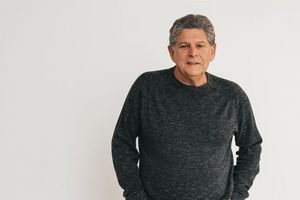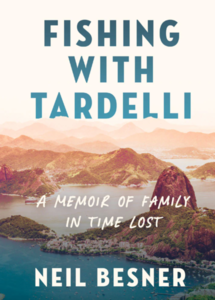Neil Besner on Memory, Márquez, and His Family Story That Was 50 Years in the Making
Family is not only constructed by how we experience it, but by how we remember it. For Neil Besner, over fifty years of remembering and thinking about his unusual upbringing led to a memoir that spans continents, family configurations, and distances both emotional and geographical.
Charting his parents' turbulent marriages and remarriages, the entrances and exits of half- and step-siblings, and moves between Canada and Brazil, Fishing with Tardelli (ECW Press) features loving, complex portraits of Besner's titular Brazilian father figure as well as those of his biological father, his stepfather, and his mother.
It is Besner's unflinching eye, captivating prose, and insightful deconstruction of memory itself that bring his story and his family, in all their complications, to life on the page, creating a narrative at once relatable and revelatory.
We're speaking with Neil today about the process of writing a book that covers more than 50 years of personal history and the surprises he found along the way. He tells us about taking the time to gain the distance necessary to do the story—and its real life characters—justice, explains why writing a memoir also became, for him, a study in memory itself, and reveals the powerhouse epigraph from Gabriel García Márquez he included, which captures the spirit of Fishing with Tardelli.
Open Book:
How did your memoir project first start? Why was this the right time to tell your story?
Neil Besner:
I have been thinking about this memoir for over ten years. It evolved from two origins: the journal I have been keeping for decades; and, somewhat more indirectly, a shorter piece I wrote at university (at McGill) in 1971. In that latter sense, I have been thinking about this book for over fifty years. The time was right because, first, the pandemic allowed me extended time to concentrate exclusively on the project; and second, I had gained enough distance from the subject – principally, my childhood and adolescence – to write about it retrospectively.
OB:
Did your memoir change significantly from when you first started working on it to the final version? Was there anything that surprised you about the process?
NB:
Yes, it changed from its (more recent) beginnings in 2020 as a published short piece of about 9,000 words in a literary journal into a book of about 35,000 words in 2022. More importantly, its range widened from a focus on fishing when I was a teenager with a Brazilian surrogate father, to include a concentration on three other parents – my mother, my stepfather, and my father – and from a restricted focus on Brazil to a wider lens onto Brazil and Canada, and a recursive structure that moved back and forth across time and between southern and northern hemispheres. And it widened to include, throughout, an inquiry into the workings of memory. It also opened out to include a wide range of references to other books, mostly novels, and to song lyrics and poems, as well as to philosophy, film, and popular culture. Finally, it came to include speculations on translation as well as its frequent practice in the book (from Portuguese into English; all the Portuguese names, phrases and slang in the memoir are immediately translated into English).
OB:
What was different for you in writing a memoir?
NB:
I’ve written and published song lyrics, poems, short stories, a lot of literary criticism, and an unpublished novel. But this project freed me to speculate on more different kinds of small “t” truths – psychological, ethical, moral. That latitude, that permission, allowed me in turn to draw more centrally on memory, which is one of my central preoccupations. The memoir form allowed me to reflect at length on how memory works.
Your CanLit News
Subscribe to Open Book’s newsletter to get local book events, literary content, writing tips, and more in your inbox
OB:
Did you use any materials, documents, interviews, or other research that became part of the writing process?
NB:
I drew extensively on a journal that I’ve been keeping for decades, and on letters, photographs, and other documents I have gathered and kept over the years. I recorded an interview with one of my brothers; but mostly I drew on memory. I also drew on many other novels, stories, poems, and other literary documents, either alluding to them or quoting from them.
OB:
Did you experience any anxiety about making a part of yourself public in this way? If so, how did you or do you cope with the vulnerability of publishing a memoir?
NB:
This was a major preoccupation: how might my immediate family respond to the memoir? How might they react to seeing themselves in print, and sometimes in what I thought they might well perceive as a harsh light? I decided that this was simply a risk that I had to take.
The risk was mitigated by the fact that three of the major figures were long dead (1991, 1994, and 2003); it was the possible responses of my parents’ six other children – my brother, two half-sisters, one half-brother and two stepbrothers (we are a mixed family) that were my major concern. My stepfather died at 99 in January 2022, four months before the book in which he is a major figure was published.
When the book was published (in May 2022), however, I was pleasantly surprised to find that my family’s responses, to a person, were quite positive.
OB:
Personal essays, memoirs, and creative nonfiction in general have becoming particularly in demand and loved by readers in recent years. Why do you think creative nonfiction is more popular than ever?
NB:
I think that increasingly, contemporary readers want to be engaged, not only by fantasy – another burgeoning genre – or mainstream fiction (i.e., a story that is made up), but by accounts that hew closer to “real life” (I quote the phrase because it is notoriously deceptive). A memoir – unlike history or biography on one hand or religious or spiritual confessions on the other (think of Augustine) – is often read today as a form that intimately evokes a time and place, and the figures who lived there, in a way that allows story – narration – to cohabit with fact, memory with imagination, what “really happened” with how the facts are narrated. We live in an age that demands faith to facts, but demands, as well, to be engaged, to be entertained. As well – perhaps because of the starkly depersonalized elements in so much of contemporary culture – we are drawn to narratives that reveal intimate and personal portraits. A good memoir fulfils many of these requirements.
OB:
When you're reading memoirs, what stands out to you and makes a really great book? Were there any published memoirs you found inspiring structurally or otherwise while working on yours?
NB:
Although Marcel Proust’s masterpiece, Remembrance of Things Past, is usually thought of as a novel, it relies centrally on a sustained discussion of memory and was my major inspiration in this regard. I am drawn to literary memoirs. I used as one of two epigraphs the closing line of Philip Roth’s brilliant 1996 memoir about his father, Patrimony: “You must not forget anything.” In my own memoir I quote the epigraph from Gabriel García Márquez’s luminous memoir, Living to Tell the Tale: “Life is not what one lived, but what one remembers and how one remembers it in order to recount it.” Numerous other memoirs have inspired me, among them two Canadian books: Joe Fiorito’s The Closer We Are To Dying, about his father, and Gabrielle Roy’s autobiography, Enchantment and Sorrow.
Above all, to my mind a memoir must draw upon memory to evoke, pungently, a time or an era, a locale, and the people that inhabited both.
____________________________________________________
Neil Besner divides his time between Toronto and Lake of the Woods. He was born in Montreal and grew up in Rio de Janeiro. He is fluent in Portuguese and returns to Brazil frequently to teach at Brazilian universities. He taught Canadian literature at the University of Winnipeg for 30 years.





